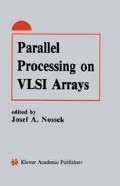Abstract
Image smoothing and segmentation algorithms are frequently formulated as optimization problems. Linear and nonlinear (reciprocal) resistive networks have solutions characterized by an extremum principle. Thus, appropriately designed networks can automatically solve certain smoothing and segmentation problems in robot vision. This paper considers switched linear resistive networks and nonlinear resistive networks for such tasks. Following [1] the latter network type is derived from the former via an intermediate stochastic formulation, and a new result relating the solution sets of the two is given for the “zero temperature” limit. We then present simulation studies of several continuation methods that can be gracefully implemented in analog VLSI and that seem to give “good” results for these nonconvex optimization problems.
Access this chapter
Tax calculation will be finalised at checkout
Purchases are for personal use only
Preview
Unable to display preview. Download preview PDF.
References
D. Geiger and F. Girosi, “Parallel and Deterministic Algorithms from MRF’s: Surface Reconstruction and Integration,” IEEE Trans. Pattern Analysis and Mach. Intell., forthcoming.
D. Geiger and A. Yuille, “A Common Framework for Image Segmentation,” in Int. Jour. Comp. Vision, forthcoming.
S. Geman and D. Geman, “Stochastic Relaxation, Gibbs Distributions, and the Bayesian Restoration of Images,” IEEE Trans. PAMI-6 (6), 1984, pp. 721–741.
J.L. Marroquin. “Optimal Bayesian Estimators for Image Segmentation and Surface Reconstruction,” MIT AI Laboratory Memo 839, April 1985.
F.S. Cohen and D.B. Cooper, “Simple Parallel Hierarchical and Relaxation Algorithms for Segmenting Noncausal Markovian Random Fields,” IEEE Trans. PAMI-9 (2), 1987, pp. 195–219.
J. Marroquin, S. Mitter, and T. Poggio, “Probabilistic Solution of Ill-Posed Problems in Computational Vision,” Jour. Amer. Stat. Assoc. (Theory and Methods), vol. 82, no. 397, 1987, pp. 76–89.
A. Blake and A. Zisserman, Visual Reconstruction, Cambridge, MA: MIT Press, 1987.
A. Blake, “Comparison of the Efficiency of Deterministic and Stochastic Algorithms for Visual Reconstruction,” IEEE Trans. PAMI-11 (1), 1989, pp. 2–12.
P. Perona and J. Malik, “Scale Space and Edge Detection Using Anisotropic Diffusion,” IEEE Trans. PAMI-12 (7), 1990, pp. 629–639.
J.M. Ortega and W.C. Rheinboldt, Iterative Solution of Nonlinear Equations in Several Variables, New York: Academic Press, 1970.
C. Koch, J. Marroquin, and A. Yuille, “Analog ‘Neuronal’ Networks in Early Vision,” Proc. Natl. Acad. Sci. USA, vol. 83, 1986, pp. 4263–4267.
D.W. Tank and J.J. Hopfield, “Simple ‘Neural’ Optimization Networks: An A/D Converter, Signal Decision Circuit, and a Linear Programming Circuit,” IEEE Trans. CAS-33(5), 1986.
D. Terzopoulos, “Multigrid Relaxation Methods and the Analysis of Lightness, Shading, and Flow,” MIT AI Laboratory Memo 803, October 1984.
W.D. Hillis, The Connection Machine, Cambridge, MA: MIT Press, 1985.
C.A. Mead, Analog VLSI and Neural Systems, Reading, MA: Addison-Wesley, 1988.
J. Harris, C. Koch, J. Luo, and J. Wyatt, “Resistive Fuses: Analog Hardware for Detecting Discontinuities in Early Vision,” in Analog VLSI Implementation of Neural Systems, C. A. Mead and M. Ismail, eds., Boston: Kluwer, 1989.
J. Harris, C. Koch, and J. Luo, “A Two-Dimensional Analog VLSI Circuit for Detecting Discontinuities in Early Vision,” Science, vol. 248, 1990, pp. 1209–1211.
J. Harris, C. Koch, E. Staats, and J. Luo, “Analog Hardware for Detecting Discontinuities in Early Vision,” Int. J. Comp. Vision, vol. 4, 1990, pp. 211–223.
T. Poggio and C. Koch, “Ill-Posed Problems in Early Vision: From Computational Theory to Analogue Networks,” Proc. Roy. Soc. Land. B 226, 1985, pp. 303–323.
B.K.P. Horn, “Parallel Networks for Machine Vision,” MIT AI Laboratory Memo 1071, August 1988.
W. Millar, “Some General Theorems for Non-Linear Systems Possessing Resistance,” Phil. Mag., 1951, pp. 1150–1160.
I. Elfadel, “Note on a Switching Network for Image Segmentation,” unpublished manuscript, October 1988.
P.M. Hart, “Reciprocity, Power Dissipation, and the Thevenin Circuit,” IEEE Trans. CAS-33(7), 1986, pp. 716–718.
P. Cristea, F. Spinei, and R. Tuduce, “Comments on ‘Reciprocity, Power Dissipation, and the Thevenin Circuit,’” IEEE Trans. CAS-34 (10), 1987, pp. 1255–1257.
P. Penfield, Jr., R. Spence, and S. Duinker, Tellegen’s Theorem and Electrical Networks, Cambridge, MA: MIT Press, 1970.
B.D.H. Tellegen, “A General Network Theorem with Applications,” Philips Res. Kept. 7, 1952, pp. 259–269.
A. Papoulis, Probability, Random Variables, and Stochastic Processes, 2nd Edition, New York: McGraw-Hill, 1984.
A. Lumsdaine, M. Silveira, and J. White, “Simlab User’s Guide,” to be published as an MIT memo.
A. Lumsdaine, M. Silveira, and J. White, “CMVSIM User’s Guide,” to be published as an MIT memo.
L.M. Silveira, A. Lumsdaine, and J.K. White, “Parallel Simulation Algorithms for Grid-Based Analog Signal Processors,” Proceedings of the International Conference on Computer Aided Design, pp. 442–445, Santa Clara, CA, 1990.
T. Richardson, “Scale Independent Piecewise Smooth Segmentation of Images Via Variational Methods,” MIT Laboratory for Information and Decision Systems Technical Report LIDS-TH-1940, February 1990.
A. Witkin, “Scale-Space Filtering,” International Joint Conference on Artificial Intelligence, pp. 1019–1021, Karlsruhe, 1983.
H. Keller, “Numerical Solution of Bifurcation and Nonlinear Eigenvalue Problems,” in Applications of Bifurcation Theory, P. Rabinowitz, ed., New York: Academic Press, 1977.
Author information
Authors and Affiliations
Editor information
Editors and Affiliations
Rights and permissions
Copyright information
© 1991 Springer Science+Business Media, New York
About this chapter
Cite this chapter
Lumsdaine, A., Wyatt, J.L., Elfadel, I.M. (1991). Nonlinear Analog Networks for Image Smoothing and Segmentation. In: Nossek, J.A. (eds) Parallel Processing on VLSI Arrays. Springer, Boston, MA. https://doi.org/10.1007/978-1-4615-4036-6_4
Download citation
DOI: https://doi.org/10.1007/978-1-4615-4036-6_4
Publisher Name: Springer, Boston, MA
Print ISBN: 978-1-4613-6805-2
Online ISBN: 978-1-4615-4036-6
eBook Packages: Springer Book Archive

